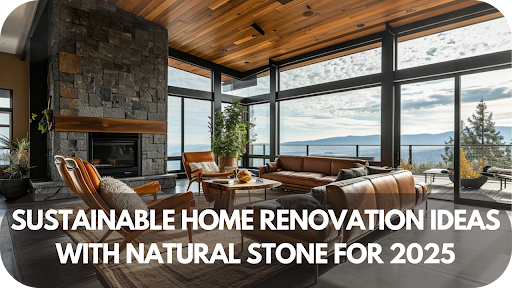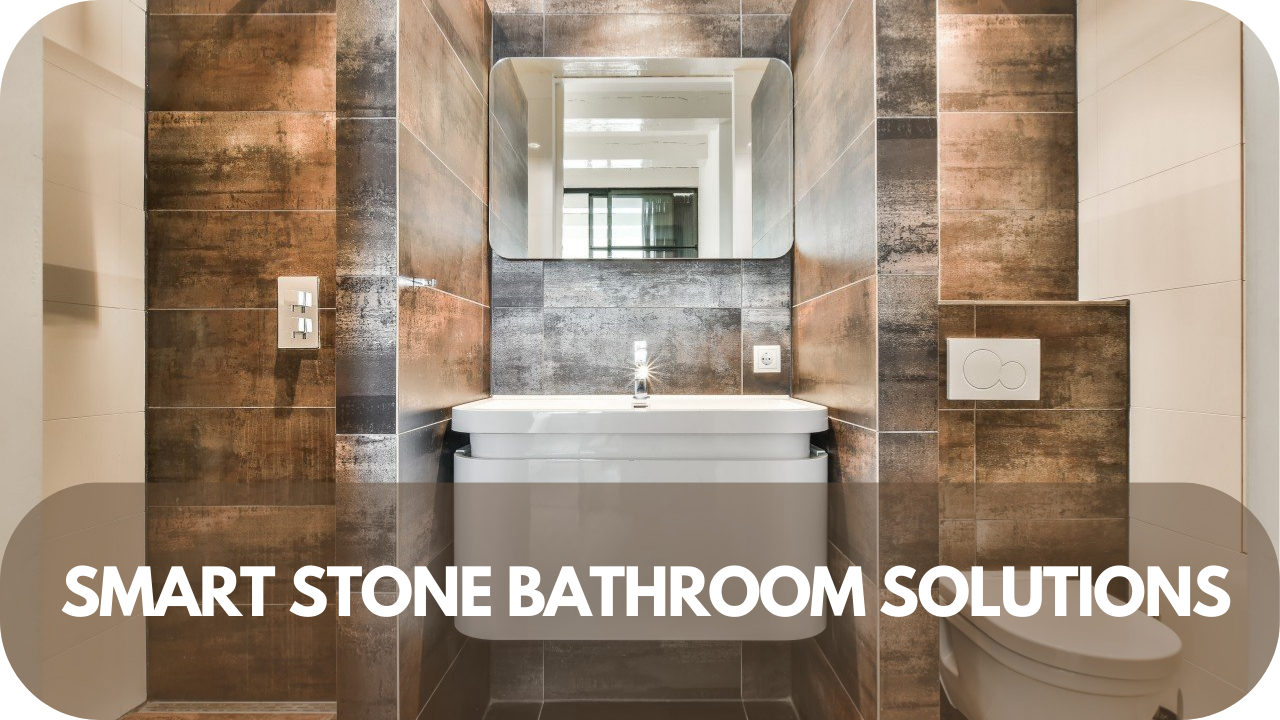
Imagine transforming your home into a sustainable haven that blends timeless beauty with eco-conscious design.
Natural stone offers an opportunity to do just that. With its durability, minimal maintenance, and environmentally friendly sourcing, natural stone has become a top choice for sustainable renovations in 2025.
Whether you’re reimagining your floors, countertops, or exterior, this material offers both style and long-term environmental benefits. This guide explores innovative ways to incorporate natural stone into your home while prioritising sustainability.
Top Sustainable Stone Renovation Ideas for 2025
I’m excited to share the best eco-friendly stone renovation ideas to transform my home into a sustainable, stylish haven in 2025.
1. Smart Thermal Mass Flooring Systems
Smart thermal mass flooring systems are revolutionising energy efficiency in modern homes. These systems use the natural thermal properties of materials like stone to absorb, store, and release heat. By capturing warmth during the day and slowly releasing it at night, they help regulate indoor temperatures without needing constant heating or cooling.
Integrating natural stone into these systems enhances their efficiency, as the stone’s thermal properties make it an ideal material for heat retention. This system also reduces energy consumption and improves comfort, making it a sustainable and practical choice for your renovation.
2. Energy-Generating Stone Surfaces
In 2025, energy-generating stone surfaces are revolutionising sustainable home renovations. These innovative stones are embedded with photovoltaic cells, allowing them to harness solar energy while maintaining the aesthetic of natural stone.
Ideal for patios, facades, or even walkways, these surfaces blend beauty with functionality, providing renewable energy without compromising design.
Their durability ensures long-lasting performance, while their ability to reduce reliance on traditional power sources makes them an essential solution for eco-conscious homeowners. With energy-generating stone surfaces, you can power your home and reduce your carbon footprint, all while enjoying a stylish, sustainable upgrade.
3. Water-Wise Stone Applications

Water-wise stone applications are essential for sustainable renovations, particularly in outdoor spaces. Permeable stone paving allows rainwater to filter through, reducing runoff and promoting groundwater replenishment.
In landscaping, stone features like dry-stacked walls can create natural drainage systems, minimising water usage. Have you considered stone basins and troughs? These can capture and store rainwater for reuse in gardens.
4. Closed-Loop Stone Kitchens
Closed-loop stone kitchens are set to be a significant trend in 2025. These kitchens use recycled stone materials for countertops and floors, promoting sustainability by reducing waste.
The closed-loop system ensures that excess stone from construction or renovation is repurposed rather than discarded, minimising environmental impact.
Stone’s durability and low-maintenance qualities make it ideal for long-term kitchen use, while its natural beauty adds a timeless aesthetic.
5. Biophilic Stone Design Elements

Incorporating biophilic design with natural stone is becoming increasingly popular in sustainable home renovations for 2025. Biophilic stone elements blend natural textures and patterns to create a calming, nature-inspired environment.
Stone features such as accent walls, countertops, and flooring can seamlessly connect indoor spaces with the outdoors, enhancing the flow of natural light and air.
These designs promote well-being by reducing stress and improving mental clarity, all while being eco-friendly and durable.
6. Health-Focused Stone Spaces
In 2025, health-focused stone spaces will become a key trend in sustainable home renovations. Natural stone’s non-toxic properties promote cleaner, healthier environments by avoiding harmful chemicals often found in synthetic materials. Stone surfaces, such as countertops and flooring, are naturally hypoallergenic, reducing dust and allergens in the home.
The cooling properties of stone can also help regulate indoor temperatures, creating a more comfortable living space.
7. Smart Stone Bathroom Solutions

Innovative stone bathroom solutions will be at the forefront of sustainable design in 2025. These innovations combine the elegance of natural stone with advanced technology, offering both style and functionality.
Heated stone floors, for example, provide warmth and comfort, while smart sensors monitor water usage, helping to conserve resources.
Stone’s natural durability ensures that these features are long-lasting, even in moisture-heavy environments, reducing the need for replacements. Additionally, stone surfaces are easy to clean and maintain, making them ideal for smart, eco-friendly bathroom designs that enhance comfort, sustainability, and modern convenience.
8. Adaptive Reuse Stone Ideas
In 2025, adaptive reuse stone ideas are an intelligent way to integrate sustainability into home renovations. Repurposing existing stone from old structures, such as walls or countertops, reduces waste and preserves natural resources.
These stones can be creatively transformed into new design elements like garden pathways, feature walls, or even outdoor seating areas.
Using reclaimed stone adds character and history to a space and reduces the carbon footprint associated with quarrying and transporting new materials.
9. Climate-Resilient Stone Exteriors

In 2025, climate-resilient stone exteriors are essential for sustainable home renovations. Natural stone offers unmatched durability, withstanding extreme weather conditions like heat waves, heavy rain, and frost. This resilience makes stone ideal for external walls, facades, and cladding, providing protection and longevity.
Stone’s thermal mass helps regulate indoor temperatures, reducing energy consumption for heating and cooling. Additionally, its resistance to moisture and wear minimises maintenance, making it a cost-effective, eco-friendly option.
10. Stone-Based Energy Solutions
In 2025, stone-based energy solutions will drive sustainable innovations in home design. Integrated into stone walls or floors, thermal energy storage systems capture and store heat during the day and release it at night to regulate indoor temperatures. This reduces reliance on conventional heating systems and lowers energy bills.
Using stone’s natural thermal properties, homeowners can efficiently manage energy consumption and create a more eco-friendly environment. These systems are especially effective in climates with wide temperature fluctuations, making stone-based energy solutions a smart, long-term investment in sustainability and home comfort.
Exploring Different Types of Sustainable Stone

Sustainable stone options provide an eco-friendly solution for home renovations, with several types offering both environmental and aesthetic benefits.
1. Granite
Granite is a highly durable stone known for its resistance to heat, scratches, and general wear. This makes it perfect for high-traffic areas like kitchens and bathrooms. Due to its longevity, granite is also an ideal choice for countertops and flooring.
By sourcing granite locally, homeowners can reduce the carbon footprint associated with transportation, making it a more sustainable option overall.
2. Limestone

Limestone offers a soft, elegant look that seamlessly fits modern and traditional design schemes. Its versatility makes it suitable for walls, floors, and exterior cladding.
Sourcing limestone from quarries that follow responsible extraction practices ensures minimal environmental impact, as it requires less energy to quarry and process than other stones.
3. Sandstone
Sandstone is widely available and highly sustainable due to its abundance and natural insulating properties.
Sandstone is beneficial in climates where temperature regulation is essential, as it helps maintain a stable indoor temperature. This can reduce energy consumption for heating and cooling, making it an aesthetic and environmentally friendly choice for home renovations.
4. Marble

Traditionally considered luxurious, marble can be eco-friendly when sourced from smaller regional suppliers. For its timeless beauty, marble is often used for countertops, flooring, and bathrooms.
By opting for sustainably quarried marble, homeowners can enjoy its elegance while reducing environmental degradation caused by large-scale mining.
5. Reclaimed Stone
Reclaimed stone is one of the most sustainable options as it involves reusing materials from demolished buildings or other structures. This approach reduces the need for new stone extraction and helps to minimise waste.
Reclaimed stone adds a sense of history and character to home renovations, offering a unique, aged aesthetic that new materials can’t replicate.
Why Choose Natural Stone for Sustainable Renovations?

Natural stone is a top choice for eco-conscious homeowners due to its durability and minimal environmental impact.
Unlike synthetic materials, natural stone is sourced directly from the earth and requires no chemical processing. This means fewer harmful emissions and less energy consumption.
Additionally, natural stone’s longevity ensures fewer replacements, reducing waste over time. Its excellent thermal properties help regulate indoor temperatures, cutting energy usage. By opting for locally sourced stone, you can further reduce transportation emissions.
For an even greener approach, consider using reclaimed stone, which offers a unique, sustainable aesthetic. Natural stone is also recyclable, making it ideal for future reuse in other projects.
Maintenance of Natural Stone for Longevity and Sustainability

Caring for natural stone is crucial for preserving its beauty and eco-friendly benefits. Here’s how you can keep it looking great for years:
- Regular cleaning: Use a pH-neutral solution to avoid damaging the stone with harsh chemicals.
- Sealing: Apply sealant to protect against stains and moisture, especially on high-use surfaces like countertops.
- Resealing: Reapply sealant periodically, particularly in heavy traffic areas or outdoors.
- Damage checks: Repair chips or cracks early to prevent further deterioration.
- Weatherproofing: Use protective treatments for outdoor stone to guard against erosion and temperature changes.
- Polishing: For smooth stone, clean with a soft cloth and warm water; for rougher surfaces, use a gentle brush.
Conclusion
Sustainable renovations with natural stone in 2025 blend timeless beauty with eco-conscious design.
This durable, recyclable material reduces waste and complements any space, making it ideal for a greener, enduring home. Visit Splendour in stone and embrace natural stone for a stylish, sustainable future.
More To Explore

8 Advantages of Using Stone Grid Gabions in Your Landscape
Are you seeking a durable, cost-effective solution to elevate your landscape? Stone grid gabions might be the perfect choice! These versatile, eco-friendly structures offer a

10 Stunning Feature Wall Ideas Using Natural Stone
Looking to elevate your home with a stunning feature wall? Natural stone offers a timeless, elegant touch that can transform any room. From sleek marble


